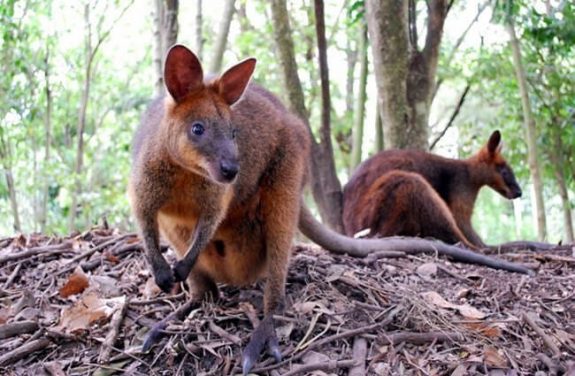Truffle munching wallabies shed new light on forest conservation

Edith Cowan University Media Release
Feeding truffles to wallabies may sound like a madcap whim of the jet-setting elite, but it may give researchers clues to preserving remnant forest systems.
Edith Cowan University researcher Dr Melissa Danks led an investigation into how swamp wallabies spread truffle spores around the environment, and results demonstrate the importance of these animals to the survival of the forest.
“There are thousands of truffle species in Australia and they play a critical role in helping our trees and woody plants to survive,” she said.
“Truffles live in a mutually beneficial relationship with these plants, helping them to uptake water and nutrients and defence against disease.
“Unlike mushrooms where spores are dispersed through wind and water from their caps, truffles are found underground with the spores inside an enclosed ball – they need to be eaten by an animal to move their spores.”
Dr Danks and colleagues at the University of New England investigated the role of swamp wallabies in dispersing these spores.
“Wallabies are browsing animals that will munch on ferns and leaves as well as a wide array of mushrooms and truffles,” she said.
“This has helped them to be more resilient to changes in the environment than smaller mammals with specialist diets like potoroos.
“We were interested in finding out whether swamp wallabies have become increasingly important in truffle dispersal with the loss of these other mammals.”
Conservation by poo tracking
The team fed truffles to wallabies and timed how long it would take for the spores to appear in the animals’ poo. Most spores appeared within 51 hours, with some taking up to three days.
Armed with this information, the researchers attached temporary GPS trackers to wallabies to map how far they move over a three-day period.
Results showed the wallabies could move hundreds of metres, and occasionally more than 1200 metres, from the original truffle source before the spores appeared in their poo, which makes them a very effective at dispersing truffles around the forest.
Dr Danks said this research had wide ranging conservation implications for Australian forests.
“As forest systems become more fragmented and increasingly under pressure, understanding spore dispersal systems is really key to forest survival,” Dr Danks said.
“Many of our bushland plants have a partnership with truffles for survival and so it is really critical to understand the role of animals in dispersing these truffle spores.
“Our research on swamp wallabies has demonstrated a simple method to predict how far an animal disperses fungal spores in a variety of landscapes.”
‘Modelling mycorrhizal fungi dispersal by the mycophagous swamp wallaby (Wallabia bicolor)’ was published in Ecology and Evolution and can be read on the website.
Like what we do at The AIMN?
You’ll like it even more knowing that your donation will help us to keep up the good fight.
Chuck in a few bucks and see just how far it goes!
Your contribution to help with the running costs of this site will be gratefully accepted.
You can donate through PayPal or credit card via the button below, or donate via bank transfer: BSB: 062500; A/c no: 10495969










2 comments
Login here Register here-
Olivia Manor -
Brad Black
Return to home pageAnd there I was, thinking it was an article about Turnbull….
Clever nature!
Would it be correct to suggest that fungal mycelium act almost as synapses enabling a whole range of communication between forest trees?